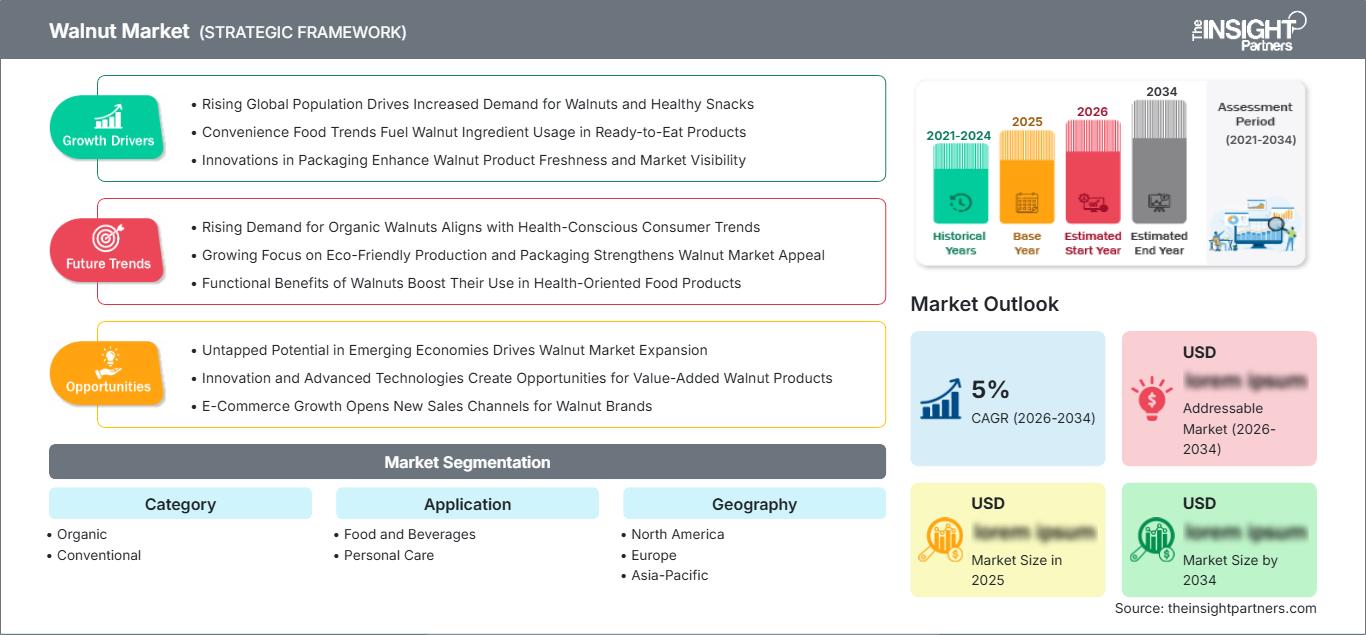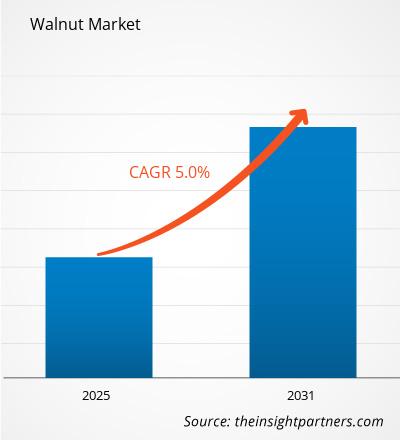Der Walnussmarkt wird voraussichtlich von 2026 bis 2034 mit einer durchschnittlichen jährlichen Wachstumsrate (CAGR) von 5 % wachsen. Die Marktbedingungen entwickeln sich stetig weiter und eröffnen den Marktteilnehmern neue Chancen. Insgesamt zeichnet sich ein stabiles Marktumfeld mit langfristigem Wachstumspotenzial ab.
Der Bericht ist nach Kategorien (Bio, konventionell) gegliedert. Er enthält außerdem eine Analyse basierend auf den Anwendungsbereichen [Lebensmittel und Getränke (Backwaren und Süßwaren, Milchprodukte und Tiefkühlprodukte, süße und herzhafte Snacks, Getränke und Sonstiges), Körperpflege und Sonstiges]. Die globale Analyse wird weiter auf regionaler Ebene und für wichtige Länder aufgeschlüsselt. Geografisch ist der Markt in Nordamerika, Europa, Asien-Pazifik, Naher Osten und Afrika sowie Süd- und Mittelamerika unterteilt. Der Bericht gibt die Werte der oben genannten Analysen und Segmente in US-Dollar an.
Zweck des Berichts
Der Bericht „Walnussmarkt“ von The Insight Partners beschreibt die aktuelle Marktlage und das zukünftige Wachstum, die wichtigsten Triebkräfte, Herausforderungen und Chancen. Er bietet Einblicke für verschiedene Akteure im Markt, wie zum Beispiel:
- Technologieanbieter/Hersteller: Um die sich entwickelnde Marktdynamik zu verstehen und die potenziellen Wachstumschancen zu erkennen, damit sie fundierte strategische Entscheidungen treffen können.
- Investoren: Um eine umfassende Trendanalyse hinsichtlich der Marktwachstumsrate, der finanziellen Marktprognosen und der Chancen entlang der gesamten Wertschöpfungskette durchzuführen.
- Regulierungsbehörden: Zur Regulierung von Richtlinien und Überwachungstätigkeiten auf dem Markt mit dem Ziel, Missbrauch zu minimieren, das Vertrauen der Anleger zu erhalten und die Integrität und Stabilität des Marktes zu wahren.
Walnussmarktsegmentierungskategorie
- Bio
- Konventionell
Anwendung
- Speisen und Getränke
- Körperpflege
Sie erhalten eine kostenlose Anpassung aller Berichte – einschließlich Teilen dieses Berichts, Länderanalysen und Excel-Datenpaketen – sowie attraktive Angebote und Rabatte für Start-ups und Universitäten.
Walnussmarkt: Strategische Einblicke

-
Ermitteln Sie die wichtigsten Markttrends dieses Berichts.Diese KOSTENLOSE Probe beinhaltet eine Datenanalyse, die von Markttrends bis hin zu Schätzungen und Prognosen reicht.
Wachstumstreiber des Walnussmarktes
- Die wachsende Weltbevölkerung treibt die Nachfrage nach Walnüssen und gesunden Snacks an: Das weltweite Bevölkerungswachstum führt zu einem deutlich erhöhten Appetit auf Lebensmittel, darunter auch Walnüsse. Dies geht einher mit einem Anstieg des Pro-Kopf-Verbrauchs von Walnüssen aufgrund der steigenden Nachfrage nach gesunden und nährstoffreichen Snacks. Dadurch hat sich der Markt weiterentwickelt und die Hersteller dazu veranlasst, ihr Produktsortiment zu diversifizieren.
- Der Trend zu Convenience-Produkten treibt die Verwendung von Walnüssen in Fertiggerichten an: Der Konsum von Convenience-Produkten – also Fertiggerichten, die direkt verzehrt oder zubereitet werden können – erfreut sich stetig wachsender Beliebtheit. Walnüsse werden in diesem Zusammenhang erfolgreich in Snacks und Backwaren integriert und steigern so den Absatz.
-
Innovationen bei Verpackungen verbessern Frische und Marktpräsenz von Walnussprodukten: Verbesserte Verpackungstechnologien erhöhen die Haltbarkeit und Attraktivität von Walnussprodukten. Solche Verpackungen tragen nicht nur zur längeren Haltbarkeit der Walnussprodukte bei, sondern verbessern auch deren Attraktivität.
Regionale Einblicke in den Walnussmarkt
Die regionalen Trends und Einflussfaktoren auf den Walnussmarkt im gesamten Prognosezeitraum wurden von den Analysten von The Insight Partners ausführlich erläutert. Dieser Abschnitt behandelt außerdem die Marktsegmente und die geografische Verteilung des Walnussmarktes in Nordamerika, Europa, Asien-Pazifik, dem Nahen Osten und Afrika sowie Süd- und Mittelamerika.
Umfang des Walnuss-Marktberichts
EuropaDurch Bewerbung- Speisen und Getränke
- Körperpflege
- Vereinigtes Königreich
- Deutschland
- Frankreich
- Russland
- Italien
- Restliches Europa
- China
- Indien
- Japan
- Australien
- Übriges Asien-Pazifik
- Brasilien
- Argentinien
- Rest von Süd- und Mittelamerika
- Südafrika
- Saudi-Arabien
- VAE
- Übriger Naher Osten und Afrika
Berichtattribute Details Marktgröße im Jahr 2025 XX Millionen US-Dollar Marktgröße bis 2034 XX Millionen US-Dollar Globale durchschnittliche jährliche Wachstumsrate (2026 - 2034) 5% Historische Daten 2021-2024 Prognosezeitraum 2026–2034 Abgedeckte Segmente Nach Kategorie - Bio
- Konventionell
Abgedeckte Regionen und Länder Nordamerika - UNS
- Kanada
- Mexiko
Marktführer und wichtige Unternehmensprofile - Alpine Pacific Nut
- Andersen Shellling Inc
- Kalifornische Walnüsse
- GoldRiver Orchards, Inc
- Grower Direct Nut Co
- Kaschmir-Walnussgruppe
- Mariani Nut Company Inc
- Morada Produce Company LP
- Poindexter Nut Company
Marktdichte der Walnussanbieter: Auswirkungen auf die Geschäftsdynamik verstehen
Der Walnussmarkt wächst rasant, angetrieben durch die steigende Nachfrage der Endverbraucher. Gründe hierfür sind unter anderem sich wandelnde Verbraucherpräferenzen, technologische Fortschritte und ein wachsendes Bewusstsein für die Vorteile des Produkts. Mit steigender Nachfrage erweitern Unternehmen ihr Angebot, entwickeln innovative Lösungen für die Bedürfnisse der Verbraucher und nutzen neue Trends, was das Marktwachstum zusätzlich beflügelt.

- Verschaffen Sie sich einen Überblick über die wichtigsten Akteure des Walnussmarktes.
- Historische Analyse (2 Jahre), Basisjahr, Prognose (7 Jahre) mit CAGR
- PEST- und SWOT-Analyse
- Marktgröße Wert/Volumen – Global, Regional, Land
- Branchen- und Wettbewerbslandschaft
- Excel-Datensatz
Aktuelle Berichte
Verwandte Berichte
Erfahrungsberichte
Grund zum Kauf
- Fundierte Entscheidungsfindung
- Marktdynamik verstehen
- Wettbewerbsanalyse
- Kundeneinblicke
- Marktprognosen
- Risikominimierung
- Strategische Planung
- Investitionsbegründung
- Identifizierung neuer Märkte
- Verbesserung von Marketingstrategien
- Steigerung der Betriebseffizienz
- Anpassung an regulatorische Trends






















 Kostenlose Probe anfordern für - Walnussmarkt
Kostenlose Probe anfordern für - Walnussmarkt